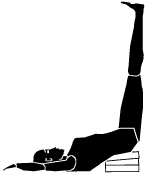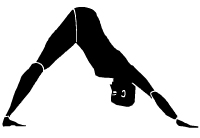Introduction

Woman's lives are deeply affected by the ebb and flow of their hormones-those mysterious and miraculous molecules that deliver vital messages via the bloodstream from one part of the body to another. Indeed, our lives are patterned by the cycles of nature, whether these are the changes of puberty, the monthly rhythms of our menstrual cycle or the passages of menopause. These changes have undisputed effects on our whole being. No woman can menstruate, give birth or cross the menopausal bridge without feeling these hormonal influences on her physical, emotional and psychological state. In many cultures, the changes in women at menstruation, childbirth and menopause are treated as a time for celebration. Unfortunately, menopause in the west is seen more as a time for decline, rather than recognizing this time in our lives as a time of change into deepening power and wisdom. View this stage in your life as a time of new awareness and broadening your personal development.
Yoga and Menopause
The Eastern traditions view menopause as a time of greater wisdom and deeper insight. It's a natural life transition, one to be embraced and celebrated. And yet, in Western culture, women often enter menopause feeling profoundly uncomfortable. Women who practice yoga have a different, more positive experience. Achieving hormonal balance during the menopausal years is essential to good health. Among the many benefits that set yoga apart from other forms of physical exercise is the effect yoga postures and breathing practices have not only on the muscles and bones of your body, but also on your organs and glands. Practicing yoga can help prevent or reduce the common symptoms that affect women specifically during the menopausal years by providing a form of treatment directed at the root causes that result in the breakdown of the healthy functioning of the body.Yoga's approach to health during menopause and beyond is based on the premise that the body should be allowed to function as efficiently, effectively and naturally as possible. On average, 1.5 million women each year begin to experience menopause after the age of 50.Nearly 85 percent have unpleasant symptoms such as interrupted or delayed sleep, night sweats, hot flashes, and anxiety. Although medical studies on the benefits of yoga are few, the majority conclude that performing yoga improves your quality of life. Many of these studies deal with particular subsets of the population, and the results overwhelming demonstrate that the practice is worth the effort.
YOGA POSES FOR MENOPAUSE
Dog Pose
The Dog Pose improves flexibility of your spine, stretches the hips and middle and low back, rejuvenates the body, and helps in preventing back problems. Take note that this Yoga Pose should not be performed if you have serious back pain or injury.Child Pose
The Child Pose is a relaxation pose which is used to normalize the circulation after the Head Stand and to give a counter stretch to the spine after the backward bends. It is a resting pose that can be done to precede or follow any pose. Performing the Child Pose stretches the hips, thighs and ankles gently. It also helps relieve stress and fatigue, and calms the brain.Standing Forward Bend Pose
Doing a Standing Forward Bend can completely stretch your upper and lower back as well as your calf muscles and legs. In addition, it can help increase the flow of brain in the brain.Simple Meditation Technique
This Meditation process is good to induce relaxation response and promotes a peaceful and relaxed mind. Meditation has also been scientifically proven to have health benefits such as lowering blood pressure and aiding the asthmatics in their breathing.Leg Lock Pose
Pavanan means wind and Muktha means escape or relief. Pavanamukhtasana is aimed at releasing gas accumulated in abdomen and at joints. This exercise is a good treatment for gastritis and vata related pain and for varicose pain. This asana strengthens muscles of abdomen. It gives strength and flexibility to backbone and muscles at back and lower backBridge Pose
The Bridge Pose is also known as Setu Bandhasana which means construction of a bridge. It came from the words setu meaning bridge, bandha meaning lock, and asana meaning posture. Setu Bandhasana is effective in promoting relaxation and reducing stress. It helps to promote a healthy flexible spine while strengthening the legs and buttock muscles.Kapalabhati
Kapalabhati is a Breathing Technique used specifically for cleansing. If you have a lot of mucus in the air passages or feel tension and blockages in the chest it is often helpful to breathe quickly.Relaxation Pose
There are three parts to proper relaxation - physical, mental and spiritual relaxation. Relaxation Yoga Pose relaxes your body and mind, and makes you feel refreshed after doing the asanas and the pranayamas.This is why it is an essential part of Yoga practice.YOGA ASANAS FOR MENOPAUSE
SUPTABADDHAKONASANA

Steps
- Sit on your heels with your knees on the floor, about hip-width apart.
- Place a bolster or two folded blankets in front of you and lean forward until your torso and head are completely supported.
- Turn your head to one side.
- Give yourself several minutes to relax and feel the soothing effect of the pose.
- Remember to breathe softly, slowly, and truly "hug" your bolster.
- Allow yourself to sink into the bolster, relax and let go. Turn your head the opposite way before sitting up.
SETUBANDHASANA

Steps
- Lie down in Shavasana posture. Raise your knees and bring your feet nearer to the hips keeping them apart. Keep your hands near the thighs.
- While inhaling, raise your hips and hands upwards simultaneously. Keep your hands over your head on the floor.
- Bring back your hands and hips to the original position while exhaling. Repeat three to four times and relax.
SARVANGASANA

Steps
- Lie on the back quite flat. Slowly raise the legs.
- Lift the trunk, hips, and legs quite vertically. Support the back with the two hands, one on either side. Rest the elbows on the ground. Press the chin against the chest.
- Allow the back-shoulder portion and neck to touch the ground closely. Do not allow the body to shake or move to and fro. Keep the legs straight.
- When the Asana is over, bring the legs down very, very slowly with elegance and not with any jerks.
- In this Asana the whole weight of the body is thrown on the shoulders. You really stand on the shoulders with the help and support of the elbows.
- Retain the breath as long as you can do with comfort, and slowly exhale through the nose.
VIPARITAKARANI

Steps
- Place a bolster or two folded blankets about 2 inches away from the wall
- Sit sideways on the bolster so your right hip and side are touching the wall. With the bolster under your bottom, lower yourself back, using the support of your elbows and forearms, and swivel around to take your right leg and then your left leg up the wall.
- Stay in the pose for 10 minutes or longer. If you are tired, it is natural to fall asleep in this pose.
- When you are ready to come out, bend your knees, turn to your side, and relax on the floor for a few more breaths before you slowly sit up.
ADHOMUKHASVANASANA

Steps
- From Supported Child's Pose, come to your hands and knees.
- Bring your knees back in line with your hips and place your hands on either side of the front edge of the bolster.
- Position your feet hip width apart, curl your toes under, press your hands firmly into the mat and, on an exhalation, straighten your legs so that your body forms the shape of a dog stretching.
- When you come down, separate your knees and come back to Supported Child's Pose.
Diseases Related to Scorpio |
||


